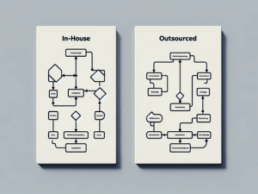Real-Time Data Monitoring for Operations
Real-time monitoring is a business practice in which employees monitor the performance of machinery and equipment. It can benefit you regardless of what kind of facility you manage or work in. In the manufacturing industry, innovation promotes productivity and safety. Real-time data monitoring and predictive maintenance can make an outstanding difference in your employees’ well-being, ultimately boosting profits by ensuring a smoothly running operation.
What Is Real-Time Data Monitoring?
Real-time data monitoring involves using sensors and other data sources to monitor a machine’s performance in any industrial setting. With real-time alerts, employees can closely monitor a machine on the work floor to track productivity and monitor potential hiccups. A real-time network isn’t just for productivity’s sake; real-time monitoring solutions allow you to observe potential safety or network security risks in your machinery.
What Is Predictive Maintenance?
Predictive maintenance is the data-based prediction of when a piece of machinery will fail. Such data is beneficial to places like a factory or plant because every machine needs maintenance at some point, no matter how carefully you use it, and understanding when that maintenance should occur can help employees work more effectively. Predictive maintenance helps solve problems before they happen, reducing downtime while promoting safety.
Another aspect of predictive maintenance is machine learning, which allows organizations to make informed decisions by analyzing real-time monitoring data. As the algorithm takes on more data, it can better understand and display results to employees and supervisors in charge, helping translate machine data and propose suggested paths forward. As a tool, machine learning assists employees in leadership positions by predicting when a machine will need maintenance, what parts are more or less likely to require repair, and what a proper maintenance schedule might look like in the future.
Why Use Machine Learning?
Unlike AI, machine learning is a tool rather than a form of intelligence per se. It does not make decisions but collects and displays data.
Why Use Real-Time Data Monitoring and Predictive Maintenance?
The benefits of real-time data monitoring and predictive maintenance encompass production and safety. Machines that break or shut down for required maintenance could halt production not just on the floor they are part of but also in entire departments to which they’re connected. By using real-time monitoring as a predictive tool for scheduled maintenance, employees can organize more effectively when a machine needs repair to minimize disruption.
Another advantage of real-time monitoring and predictive maintenance is that it keeps everyone on the floor safe. A data monitoring system that notices an anomaly with a machine could save someone from harm by stopping production and fixing the machine immediately, especially if running it in its current state poses a danger to those working with and around it. Recognizing safety hazards is yet another reason innovations like real-time monitoring, machine learning, and predictive maintenance are important for any workplace.
Used with permission from Article Aggregator
This Google Sheets Update Could Improve Productivity
Like all of Google Suite, Google Sheets is a convenient tool available to any Google user who needs it. Online collaboration tools make work smoother, so Google Sheets is rolling out an update to improve productivity: smooth scrolling. This highly requested feature allows you finer control over how you view your spreadsheet in Google Sheets, allowing you to use your Google Workspace more effectively as you organize, locate, and edit files.
Google Sheets Unveils Smooth Scrolling Feature
This newly updated feature will join Google Sheets to make navigation more intuitive. Scrolling can be a bit choppy when you open a given Google Sheet project, especially on a default sheet. Much to the frustration of many, you can’t simply scroll from row 1 to row 2. Instead, the Google Sheet will scroll you from row 1 to row 5 or perhaps even further down, depending on your mouse wheel settings.
With smooth scrolling, you can better control how far you scroll each time you try to navigate in your Google Sheets document. This feature will be available to all Google customers, including those with Google Workspace, those with Google accounts who use Sheets, and those who are Google subscribers. This upgrade to Google Sheets will work seamlessly with other features that already make Google Sheets convenient, meshing well with features like hidden columns, charts, comments, frozen rows, and buttons. Even if your rows are large and your layouts unusual, smooth scrolling will work so that you can scroll wherever you need to in Google Sheets, thanks to the latest Google Sheets update.
Google Sheets Smooth Scrolling Could Help Improve Productivity
With this latest update, we could see a spike in productivity for all those who use Google Sheets for work. This robustly requested feature is desirable because it helps multiple kinds of users navigate documents far more easily. Smooth scrolling isn’t just a big deal for Google Sheets users using desktop computers; it’s also a major software improvement for those working exclusively on laptops, using a trackpad to navigate their documents daily.
Another recent update to Google Sheets is for those still on the fence about Excel vs. Sheets. If you’ve been concerned about transferring your sensitive Excel spreadsheets to Google Sheets, you’ll no longer need to worry. Google recently announced that users will soon be able to convert Microsoft Excel files into Google Sheets through client-side encrypted processes.
Google continues to improve by listening carefully to its users’ needs and preferences and making changes accordingly. Plenty of updates are coming to software features like Google Meets and more, with issue detection and description being one of the more recent additions. With this latest update to Google Sheets, you can scroll more effectively in your newest documents and old Sheets. With functions like the Comments feature undergoing updates across the Google Workspace landscape, users will more easily navigate collaborative projects thanks to the latest Google Sheets update.
Used with permission from Article Aggregator
The Rise of Insider Threats
The greatest threat to your security is not an anonymous hacker working from a remote location but, more than likely, an in-house employee who knows all your trade secrets. In businesses, insider threats are more than security issues; they impact a business’s reputation and financial health. How can we avoid insider threats? Is there a way to ramp up threat detection to minimize malicious insider threat risk?
Where Do Insider Threats Come From?
Disgruntled Employees
Insider threats usually result less from a lack of proper training or a faulty security system and more from employee dissatisfaction, which varies depending on a business’s climate. Employees with legitimate access, namely those in IT or other security-adjacent functions with access to sensitive information, are often responsible for insider threats. While one can’t necessarily predict how employees will respond to sudden changes at work, monitoring their access can help.
Third-Party Employees and Contractors
Another reason a business may experience insider threats is that the employees in question require privileged access to work. This goes beyond just IT and security personnel; it means anyone who needs certain permissions to hold any position in the company. If third-party relations are broken without the proper permissions being revoked simultaneously, it can mean big potential losses for the company via exploited assets.
Layoff Stress
During times of uncertainty, employees are more likely to act maliciously with the information they have. When employees discover they will be laid off, they may horde information against the company as revenge for their sudden displacement. Given how common layoffs are in today’s work climate, the average employee is more likely than ever to be a suspect of threatening assets and company information.
Financial Pressing
As with layoffs, financial stress can lead to employees misusing information entrusted to them. Most instances of insider threats revolve around monetary gain. Because of rising inflation costs and stagnant wages, employees such as financial controllers stand a lot to gain from having access to bank account numbers, routing information, and more.
Stressed Employees
Employees facing undue stress due to layoffs and financial problems are more likely to make unfortunate mistakes. The same is true across the board regarding a business, especially regarding sensitive company information. Even if you don’t have malicious employees making insider threats on your roster, factors like burnout can impact an employee’s ability to spot scams and avoid potential breaches in information.
Improved Security Means Improved Control
Because there are plenty of variables to insider threats, the proper course of action is to take control of the information that can become a threat. Controlling who has privileged information is a start, helping prevent data leaks by only giving such information to 100% trustworthy employees. Restricting those with privileges, keeping tabs on data transfer, and maintaining visibility on what information comes and goes are the best ways to protect against insider threats. While trust is important for a company, too much can lead to flimsy cyber-security and vulnerable digital assets.
Used with permission from Article Aggregator
Financial Advisor Loses $50K To A Scammer
Horror stories of people getting scammed out of hundreds or even thousands of dollars aren’t in short supply. As we scroll through the news app from the comfort of our couch, reading these accounts of how a stupid so-and-so opened an obviously suspicious attachment and a hacker drained their bank account, it’s easy to say things like “I’d never fall for that!” But would you?
The sobering truth is that, under the right conditions and with the right threat, anyone can fall victim to a financially devastating scam. This reality was recently demonstrated when a finance guru, someone armed with enough financial acumen to publicly advise others, lost $50,000 to a scammer pretending to be a CIA agent.
Charlotte Cowles, a seasoned financial advice columnist for New York Magazine’s digital fashion news site, The Cut, wrote a first-person account of how she boxed up $50,000 in cash in a shoebox, walked it out to the sidewalk in front of her house and willingly handed it over to an unknown person in a white Mercedes SUV. Looking back, she was humiliated that she couldn’t see the red flags, but the way these criminals intricately plotted every step would have convinced most people.
I suggest giving her detailed story a read, but to give you the nutshell version, this elaborate scam started early in the day when a woman from “Amazon’s customer service” called to inquire about unusual activity on Charlotte’s account. The woman told her this has been a frequent issue for the company, provided a case number ID and recommended Charlotte check her credit cards immediately. She shared that the issue was so prevalent that the company was working with a liaison at the Federal Trade Commission and offered to refer her to him for additional assistance.
Once connected, the FTC agent provided his badge number for reassurance and a direct number to reach him at, and confirmed personal details like her full name and Social Security number. Convincing, right? That’s when things took a turn. The agent shared that he had been following her case for some time, and to date, there were 22 bank accounts, nine vehicles and four properties registered under her name. The bank accounts had wired more than $3 million overseas, mostly to Jamaica and Iraq, and he wondered if she could tell him anything about this.
This crazy scheme escalated from there. The agent texted her a photo of her ID, claiming it had been found in a car rented under her name that was abandoned on the southern border of Texas with blood and drugs in the trunk and was linked to an even bigger drug raid. He told her there were warrants out for her arrest in multiple states and that she was facing heavy charges of cybercrime, money laundering and drug trafficking.
She frantically googled her name, looking for any warrants. Nothing. Sensing her rising discomfort, he asked if she had recently used public WiFi. She had, at the airport. “Ahh…” he said, “that’s how most of these things start.”
As she texted her husband that she was in serious trouble, the agent offered her a solution, but she could tell no one. Everyone was a suspect, and they were watching her every move. The agent said her laptop was hacked, her home was being watched and they could even see her two-year-old son playing in the living room right now. At the mention of her son, she was all in to resolve the problem. Sadly, you know the heartbreaking ending of the story. She drained her savings and hand-delivered it in a floral-printed shoebox to the scammer.
Here's the real kicker: if Cowles, armed with financial acumen and a journalist’s skepticism, can be led astray, what chance do the rest of us stand? It’s a digital Wild West out there, folks, and the outlaws are on the prowl, looking for their next big score. This tale isn’t just a wake-up call – it’s a blaring siren for small business owners everywhere. If you think you’re too smart to get scammed, think again, because it’s happening all the time.
When Charlotte began to share her story, everyone seemed to know someone who had gone up against a scammer and lost. One friend’s criminal-defense-attorney father had been scammed out of $1.2 million. Another was a real estate developer duped into wiring $450,000 to someone posing as one of his contractors. Even a Wall Street executive, who had been conned into draining her 401(k) by a guy she met at a bar. These stories are everywhere.
Cyber security cannot be ignored. With the AI tools available, scams are becoming more and more difficult to identify. If you want to protect yourself, your family and your business, you absolutely MUST take your security seriously. Every day, hackers are buying and selling personal information, like Charlotte’s Social Security number, on the dark web to hackers who will use it to run scams just like this one. You or your loved ones could be next.
This ISN’T meant to scare you, although it should; it’s meant to educate you and give you the upper hand to go up against these criminals. To protect what’s yours. The best way we can help is to offer a FREE Cyber Security Risk Assessment. We’ll do an in-depth evaluation of your network’s security system, including scanning the dark web for leaked information, and provide you with a comprehensive report of what you need to do to be secure.
You can book your Assessment with one of our experts for FREE by going to https://www.teamspring.us/discoverycall/ or calling 770-614-9495.
How Businesses Can Protect Themselves From API Security Vulnerabilities
Does your business use an API? What's your feeling about the increase in cyberattacks on businesses through these essential software intermediaries? Keep reading to learn everything your business should know about API attacks and safety measures that work.
What Is An API?
Application programming interfaces are ways for two or more computer programs to understand each other. They're like user interfaces (where a person interacts with a site or software) but for computer programs.
Your API works by sharing information between programs—one software makes an API request, and the other sends the requested information through the same channel.
What Makes Your Business' APIs Vulnerable?
How can businesses protect themselves from API security vulnerabilities? What makes an API vulnerable?
The biggest risk of using an API is the potential transmission of sensitive information that your business should rather be protecting, such as:
Passwords
Financial information
Medical histories
Without a secure API, cyber attackers may hijack this information.
The Problem of Rising API Attacks on Businesses
Businesses of all sizes have seen a significant increase in cyber attackers using API vulnerabilities to obtain their company's critical information.
In 2023, API attacks comprised 27% of all infiltrations (a 10% increase from the previous year). These attacks most frequently targeted a user's account in an ATO (account takeover). Financial information also showed up prominently in API-targeted attack targets.
In general, attackers use increasingly complicated methods of bypassing API security, necessitating improved API development to mitigate these rising threats. Businesses automate their API requests (one source estimates they've reached 1.5 billion requests annually), but this increase in automated requests comes with a greater likelihood of a hacker accessing your organization's or customers' information.
Protecting Your Business From API Attacks
Do you use an API for your business? Don't worry; you can incorporate several best practices to secure your information.
Don't Delay in Securing Your API Software at Work
API attacks can happen at any time. Immediate action allows your business to avoid the serious consequences of a successful API breach. Solutions like retraining your employees or implementing defensive software can take days or weeks to fully implement, so begin right now if you can.
Start with something as simple as emailing your employees or IT team. You want to make security measures a top priority and fast.
Improve Your Business Security Tools and Standard Operating Procedures
Businesses can also protect themselves from API security vulnerabilities using tools like OAuth or JWT to transmit data securely. These examples don't use a password to send and receive requests.
You should also confirm your API key remains private. Accidentally enabling public access to these security measures is a leading cause of disastrous API attacks.
As a business owner, it's important to understand how your API dependence affects your organization's integrity. Protect yourself or get some help in setting up these measures.
Used with permission from Article Aggregator
Gmail Is Making Customization Easier for Businesses
If you use Google Workspace, you'll benefit considerably from the new features Google is rolling out in 2024's second quarter. The changes come primarily from Gmail templates and features, so anyone who sends emails can benefit.
Keep reading to learn everything you should know about these updates, including what they are, how to use them, and the difference Google's improvements can make to your work team.
Improvements to Google Workspace
With these updates, Google rolls out a host of features to the Gmail app and supporting programs, many of which build on Google's previous updates from 2022 (when they introduced layouts) and 2023 (when your business could start customizing templates, among other features).
Business Template Access
With the new updates, even more Google Workspace users can access these professional features. The full rollout (April 2024) grants access to subscribers to any of the following Workspaces:
Business
Enterprise
Education
Individual
Further Improved Layout Editor For Businesses
Most of the features focus on improving the email template offerings, creating increased customization options, and generating content faster. That means business owners can now easily craft their templates or choose from existing ones that focus on specific purposes, such as a newsletter. Some of those formats are simply stunning.
With the updates to Smart Compose, your employees can also type content faster and more confidently—there won't be poor grammar or awkward sentences. These suggestions adapt based on the context of your sentence, sounding both professional and realistic. You can even complete the sentence by hitting the tab button.
From a business perspective, the fact that you can change nearly every aspect of these templates is invaluable. That includes the color schemes and logos to brand your emails better. You can also add footer text.
Better Collaboration
Google has also ensured that your business can now share templates with others for live changes to these templates in Gmail.
Hit the share button to work together in real-time to create the perfect draft.
Google Drive Interaction
With improved integration with Google Drive, you can open email templates in either application and craft your email. This makes it easy to insert assets from your company's Drive folders.
You should spend less time crafting an email and not need to rely on other third-party applications.
How To Implement These Changes
While every employee with a Google Workspace email address can benefit from these changes, network admins must activate them first. While on by default, you can manage access to email templates for specific domains. This gives you complete control and may reduce the frequency of spam, phishing, and malware problems.
Your business can also manage specific app access. For example, if you want to maintain access to Drive for file management but don't want certain users creating sheets or drawings, the permissions make this possible.
Whether you're an end user or a network administrator, you can benefit from all the new features of Google Workspace for Gmail. Read more about the changes at Google's help center.
Used with permission from Article Aggregator
Optimizing Your Digital Service Delivery
As a business owner who supplies digital services, you know how things outside your control can decrease your delivery capability. With the following tips for optimizing your digital service delivery, you empower your staff to deliver more consistent service and avoid the customer complaints that come with unoptimized delivery.
The Problems With Unoptimized Service Delivery
Whether you're a restaurant owner who depends on third-party delivery apps or a project manager for a team creating digital services, you've experienced glitches in service delivery. However, many customers remain unaware of all the factors outside your control, so problems reflect poorly on you even when they shouldn't.
By optimizing your digital delivery process, you mitigate the risk to both you and your customers and help create an image of competence and quality for your brand.
Tips for Optimizing Your Digital Service Delivery
To improve how you optimize your digital service delivery, follow these five tips.
1. Define Standards
Optimizing your digital service delivery starts with defining your standards. These are the expectations you set for your staff in delivering quality service, and they rely on understanding the digital customer experience, including the following:
Needs
Preferences
Pain points
You balance this information with your capabilities and business goals to make data-driven decisions and improve quality, consistency, and efficiency in delivering digital services.
2. Automate Where Possible
With technology constantly evolving, you'll have increasing opportunities to automate your digital service delivery. Automation is an investment that helps you streamline your delivery, reduce manual labor, and decrease the frequency of mistakes that cost you profit and satisfied customers.
Effective tools for automation include:
Chatbots that can answer simple questions or route customers to a person who can help them
Self-service portals for automated scheduling and payment
CRM systems that gather, compile, and analyze customer data
AI tools that can provide the basis for your digital content or marketing
Analytics that quickly give you insight so you can make better decisions
However, it would help if you didn't automate everything. Keep your customer service staff to help manage emotional customer complaints and have a team of trusted individuals to help make more complicated decisions.
3. Empower Service Staff
Empowering your staff to deliver quality and consistent service is important to long-term success. The best way to empower them is to train and coach them using positive feedback and an environment of collaboration, growth, and encouragement. When they feel capable and valued, your staff will deliver a higher quality of service more consistently.
4. Monitor Performance
Your customer base is constantly evolving, and with it, their perspective on digital experiences also changes. Ensuring your digital service delivery doesn't lag requires constantly monitoring and analyzing your performance and making timely data-driven adjustments.
5. Adapt Through Innovation
Innovation provides several efficient and affordable ways to optimize your digital service delivery in response to changing customer preferences. Consider any of the following tools to adapt innovatively:
Design thinking
Mapping the customer journey
Seeking feedback from customers, staff, and shareholders
Discover how optimizing your digital service delivery can help your business.
Used with permission from Article Aggregator
The Benefits of Business Process Outsourcing
Maintaining steady growth and productivity requires a balance between in-house staff and outsourced resources. Business process outsourcing is an overarching term for outsourcing a specific business process task, such as payroll, app development, or customer service.
What are the benefits of business process outsourcing (BPO)? In this post, we discuss the top BPO benefits for businesses.
Reduce Your Labor Costs
Most businesses spend a huge chunk of their budget on labor. Everything from salaries to health care, training, and other perks add up quickly. Outsourcing allows you to significantly reduce or eliminate labor-related expenses and enjoy cost-effective BPO solutions.
Fast-Track Growth
During growth, companies often need help scaling their operations and staff. For example, hiring and supporting full-time employees during a rapid growth phase may kill momentum and limit the potential for growth.
Steady growth, one of the advantages of the outsourcing process, keeps you in business and improves your bottom line.
Retain Flexibility
Outsourcing provides much-needed flexibility if your business has a fluctuating or seasonal demand pattern. You can staff up before a busy season without the heavy financial commitment of hiring full-time employees.
Once you make it through peak season, outsourcing allows you to switch back to your in-house team seamlessly.
Benefit From Top Talent
Top talent often goes to the largest firms because they offer the most attractive pay and benefits. Outsourcing agencies invest in top talent to ensure competitive results and customer satisfaction. By outsourcing, you gain access to top talent and boost your ability to achieve the best results.
Maintain Company Focus
Outsourcing can improve business efficiency. Allowing internal members to focus on primary tasks helps your business run more efficiently and increases your return on investment. Expect seasoned outsourcing companies to represent your business with the highest standards.
Fulfill Compliance Requirements
Regulations change frequently. The cost of compliance, to say little of the severe consequences of noncompliance, comes with significant financial impacts. Poorly trained staff who don’t follow strict regulations can cost a steep price.
With the resources of a large outsourcing firm, you can enjoy the benefits of compliance and avoid hefty fines, potential lawsuits, and other challenges that come with noncompliance.
Gain a Competitive Advantage
If you run a small business, don’t overlook the benefits of business process outsourcing. You can maintain a small core of staff while accessing countrywide or global resources that allow you to offer more services at better prices than competitors.
In the case of tight profit margins, providing quicker turnarounds or superior customer service makes a huge difference in attracting and retaining clients.
Ultimately, strategic outsourcing benefits, from professional representation to flexibility, can be seen as businesses of all sizes stand to benefit from BPO.
Used with permission from Article Aggregator
Improving Your Small Business
Small businesses face a high degree of competition on virtually all fronts. This level of competition means that small businesses must distinguish themselves from their contemporaries to achieve entrepreneurial success.
When it comes to small business growth, tweaking the small things can make operations run smoother. With that in mind, let's review some simple yet effective strategies for improving small business productivity.
Work on Documentation
One of the biggest pitfalls small businesses face is improper organization and documentation. Bad organization costs precious time and resources and can negatively affect your business's reputation and professionalism. Imagine a customer calls asking a question, and you don't have the records organized to give a proper answer.
To that end, small businesses must amp up their documentation efforts to dot every "I" and cross every "t." Documentation includes things like:
Keeping all records of business finances, including customer transactions, cash receipts, and invoices from independent contractors.
Ensure all deadlines are marked on a shared calendar that all relevant team members can access.
Keep all regulatory documentation together and periodically review it to ensure your business is compliant.
Automate Smaller Tasks
All businesses have to complete repeatable and routine tasks daily. One way to streamline business enhancement and increase operational efficiency is to automate as many of these smaller tasks as you can so you can free up resources and brain power for more complicated tasks and strategic development.
For example, you can automate your CRM to follow up automatically with customers who abandon their carts before checkout. As another example, you can buy software to automate payroll tasks. AI also gives new avenues for improving your small business, such as automated chat support bots.
Surveys have indicated that businesses and workers could save between six and seven hours of busy work each week if they had access to the proper automation tools. That is nearly an extra full day of productivity, which can be a major profitability boost.
Get Customer Feedback
Small businesses must prioritize their customers' needs and desires — after all, they buy your products and services! Therefore, allowing customer feedback is one simple way to engage with customers and improve customer relations. For example, you can send recent customers a short survey asking them about their experience and what the company could do better.
Feedback gives businesses new ideas about improving the customer experience while boosting customer engagement. Customers who see businesses taking and implementing feedback are more likely to trust and respect the brand.
Prioritize Your Website
About 80% of US consumers shop online, meaning you must prioritize your website design and UX experience toward the goal of improving your small business. A bad UX experience or a slow website can cause many to abandon your page without buying anything. Also, a poorly designed and optimized website negatively impacts your business's capabilities and reputation, undermining all the hard work you've put into customer acquisition and retention.
Used with permission from Article Aggregator
Microsoft’s Copilot Chatbot Builder
If you use chatbots to simplify repetitive tasks in your business, the news that Microsoft's Copilot Chatbot Builder is now a standard feature of a Copilot Pro subscription will be welcome. In addition, subscribers can now use Copilot within Microsoft 365 apps, eliminating the need to purchase an additional subscription if they want access to generative AI functionality on Microsoft Teams and more.
While previous versions of Copilot included a selection of ready-to-use chatbots for tasks like cooking, vacation planning, and working out, the Builder tool allows you to create your own for specialized functions.
How Microsoft's Copilot Chatbot Builder Works
Microsoft's Copilot Chatbot Builder doesn't require any coding skills. Instead, you can use a series of prompts, guides, and natural language to build a chatbot for virtually any function.
First, you give the chatbot a name and describe its purpose, giving it instructions for what you want it to do.
The Copilot Chatbot Builder may ask additional questions to clarify your task and provide sample prompts, including topics to avoid or include in responses. Once you answer all the questions, the builder will produce the chatbot you can add to your site.
One of the most useful features of the Chatbot Builder for businesses is the ability to specify Retrieval Augmented Generation for responses. This feature ensures that the chatbot pulls information from your organization to provide accurate responses. For instance, if you want to provide a place where employees can search for answers regarding your company policies, use RAG to build the chatbot, which focuses the responses on your company data.
Microsoft's Copilot Chatbot Builder also includes the ability to create GPTs that generate images using DALL-E 3's image generation function.
Using Chatbot Builder to Your Advantage
Adding the Chatbot Builder to Microsoft Copilot can save you a lot of time, especially if you regularly use Copilot's AI functions to perform daily business tasks. Instead of entering elaborate instructions whenever you need to complete the same functions, you can use the custom chatbot to perform the query.
If you choose the option in the building menu that makes your custom GPTs public, they can play an important role in many facets of your company, including HR management and customer service. From a management perspective, a chatbot can reduce time spent answering repetitive questions or tackling simple tasks, freeing your schedule for other priorities.
Microsoft's Copilot Chatbot Builder is now available to all Copilot Pro subscribers. A subscription is $30 per month.
Used with permission from Article Aggregator









